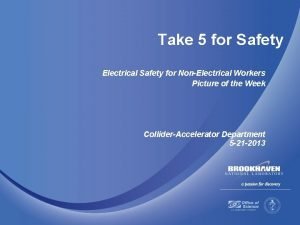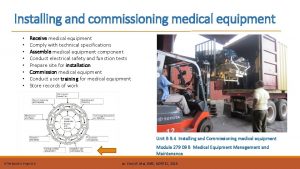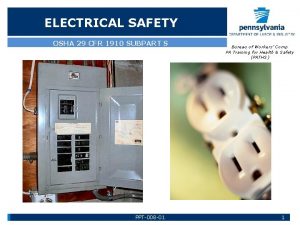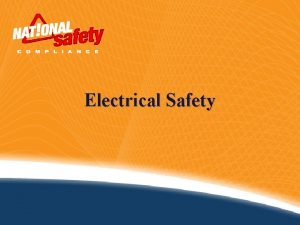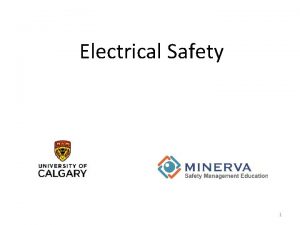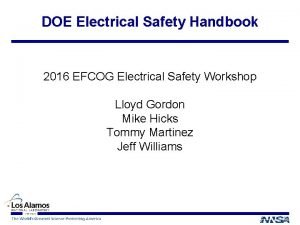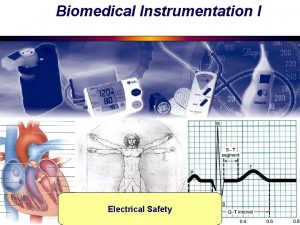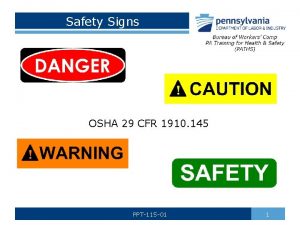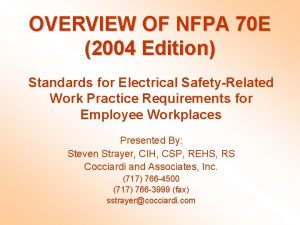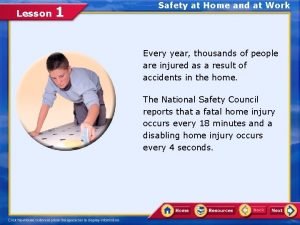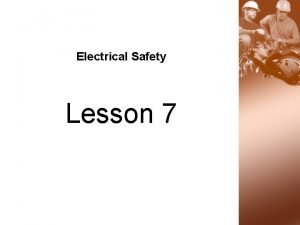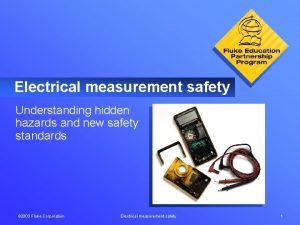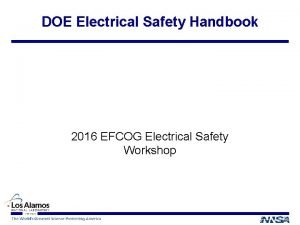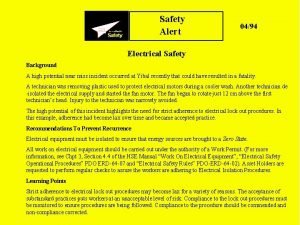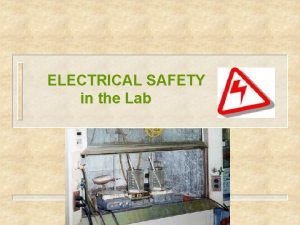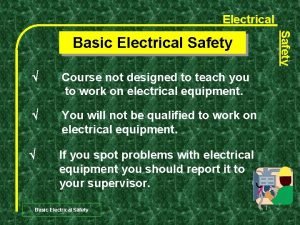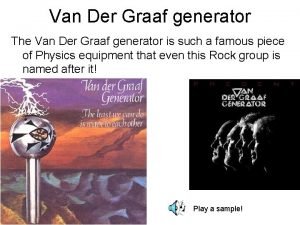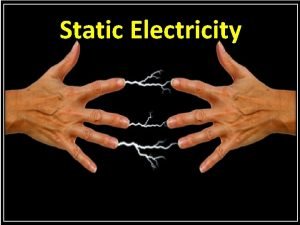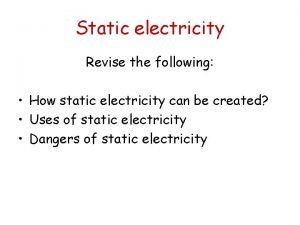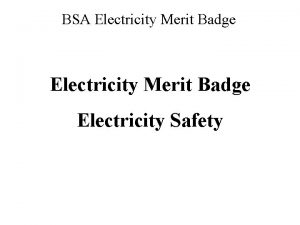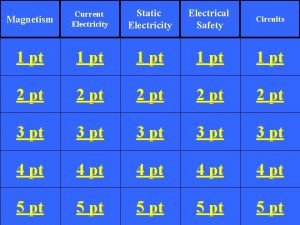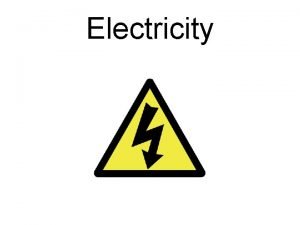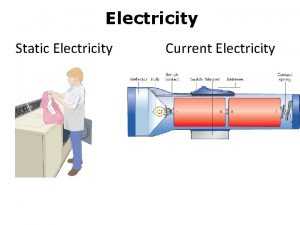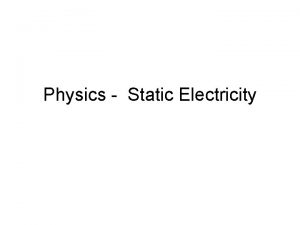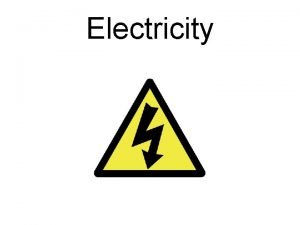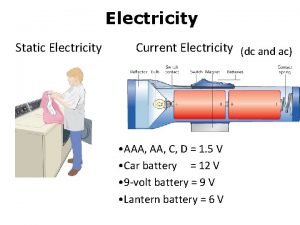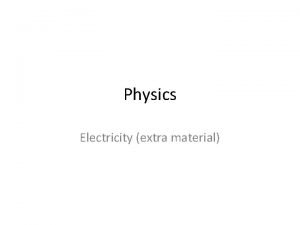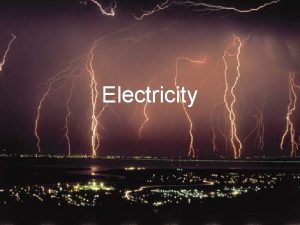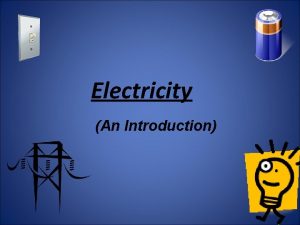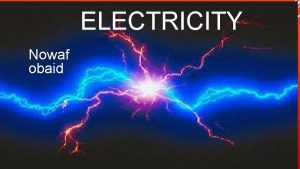EMA110 Electrical Safety EMA110 Electrical Safety Take Electricity









































- Slides: 41

EMA-110 Electrical Safety

EMA-110 Electrical Safety


Take Electricity Seriously èElectricity is the second leading cause of death in construction. èElectrocutions make up 12% of construction fatalities annually. èOver 30, 000 non-fatal shocks occur each year. èOver 600 deaths occur annually due to electrocution. Source: Bureau of Labor Statistics

Electrical Accidents è Leading Causes of Electrical Accidents: – Drilling and cutting through cables – Using defective tools, cables and equipment – Failure to de-energize circuits and follow Lockout/Tagout procedures – Failure to guard live parts from accidental worker contact – Unqualified employees working with electricity – By-passing electrical protective devices – Not using GFCI (ground fault circuit interrupters) devices – Missing ground prongs on extension cords

Hazards of Electricity è Shock – Most common and can cause electrocution or muscle contraction leading to secondary injury which includes falls è Fires – Enough heat or sparks can ignite combustible materials è Explosions – Electrical spark can ignite vapors in the air è Arc Flash - can cause burns ranging from 14, 000 degrees f. to 35, 000 degrees f è Arc Blast – In a short circuit event copper can expand 67, 000 times. The expansion causes a pressure wave. Air also expands adding to the pressure wave

Hazards of Electricity

Insulation Fault

Current Flows in a Loop or Circuit è Circuits are AC (alternating current) or DC (direct current). è Current is usually AC. è AC current has five parts: (1) Electrical source (2) HOT wire to the tool. (3) The tool itself (4) NEUTRAL wire returns electricity from the tool (5) GROUND

How Shocks Occur èCurrent travels in closed circuits through conductors (water, metal, the human body). èShock occurs when the body becomes a part of the circuit. èCurrent enters at one point & leaves at another.

Shocks Occur in Three Ways è Contact with both conductors è Contact with one conductor and ground è With a tool: contact with “hot” metal part and ground (1), (2) & (3)

Severity of the Shock èSeverity of the Shock depends on: – Amount of current • Determined by voltage and resistance to flow – Path through the body – Duration of flow through the body – Other factors such as general health and individual differences.

He sweats - and he dies. . . Luling, La. - A man was electrocuted when his sweat dripped into the electric drill he was using to build a swing set in his backyard, the coroner said. Richard Miller was pronounced dead Sunday at St. Charles Hospital, said David Vial, St. Charles Parish coroner. Miller, 54, had been using an electric drill in 90 degree heat, Vial said Monday. “Apparently the man was sweating profusely, ” Vial said. “He probably was pushing against the drill with his chest and his perspiration went into the drill itself and made a contact. ” The Associated Press

Effects of Current Flow è More than 3 milliamps (ma): painful shock è More than 10 ma: muscle contraction è More than 20 ma: considered severe shock è More than 30 ma: lung paralysis - usually temporary è More than 50 ma: possible ventricular fibrillation (usually fatal) è 100 ma to 4 amps: certain ventricular fibrillation (fatal) è Over 4 amps: heart paralysis; severe burns

Using a 120 volt circuit and resistance for wet & dry skin: E=IR: Voltage=Current x Resistance (Volts) (Amps) (Ohms) So: I=E/R Dry Skin =120/100, 000=. 0012 amps =1. 2 ma flowing through body to ground Wet skin =120/1000=. 120 amps =120 ma flowing through body to ground Remember: 1 Amp = 1000 milliamps

Effects of Current Flow

Insulating the Conductors è The first way to safeguard workers from electrically energized wires is through insulation. è Rubber and plastic is put on wires to prevent shock, fires, short circuits and for strain relief. è It is always necessary to check the insulation on equipment and cords before plugging them in. è Remember, even the smallest defect will allow leakage!

Defective Extension Cords

Defective Cord Incident è Worker attempted to climb scaffold with electric drill. è Drill’s cord was damaged with bare wires showing. è The bare wire contacted the scaffolding. è The worker died!

Elevating the Conductors è The second way to safeguard workers from electrically energized wires is by elevating them. è Wires are often elevated by the power company. è It is always necessary to check the location of overhead lines before you begin work each day. è Remember, never allow yourself, your tools, or the materials you are working with to be within 10 feet of energized lines!

Working Near Overhead Lines è Clearance of worker and any equipment, tools, materials, or scaffold near uninsulated lines is 10 feet!

Overhead Line Incident èA worker was attempting to move mobile scaffold. èScaffold made contact with 7200 volt line. èThe worker died.

Equipment Grounding è We can be safe by providing a separate, low resistance pathway for electricity when it does not follow normal flow (ground prong). è Grounding gives the stray current somewhere to go and keeps you from becoming part of the circuit.

Can You Rely on Grounding? èGrounding will not work if the electricity can flow through you more easily than the ground. This can happen when: – Your tool doesn’t have a ground pin. – You’re working in wet locations. – You’re touching a metal object.

What Must be Grounded? èAll circuits and extension cords. èAll noncurrent carrying metal parts. èPortable & semi-portable tools and equipment unless double insulated.

Do Not Eliminate the Ground! You become the next-best path for current!

Do Not Reverse Polarity The prongs are different sized so you can’t turn the plug around. If you do, the electrical fields within the motor are always energized. If there is moisture present, the case is likely to be “hot”. Even with double-insulated tools, you still could get a shock.

Circuit Interruption è We can be safer by automatically shutting off the flow of electricity in the event of leakage, overload, or short circuit. è Ground Fault Circuit Interrupters (GFCI) are circuit protection (or “overcurrent”) devices that protect you, the worker. è Circuit breakers & fuses protect equipment, not you, because they take too much current & too much time to trip.

Circuit Protective Devices èCircuit Breakers and Fuses – Only protect the building, equipment, and tools from heat build-up! – Never depend on circuit breakers or fuses to prevent shocks! èGround Fault Circuit Interrupter (GFCI) – Is the only device which will protect the worker from shock and electrocution!

Types of GFCI Protection

GFCI Testers

Checking for Ground Continuity What else we should we notice here?

Extension Cords and Cables è Must be in good shape without splices. è Cannot be secured with staples, nails or bare wire. è Must be protected from damage. è Must have a ground pin. è Should be inspected regularly and pulled from service if defective. è Cannot be repaired with electrical or duct tape. Must repair with heat-shrink sleeve or bonding/vulcanizing tape to retain original insulation properties.

Clever Or Foolish?

Clever Or Foolish?

What Could Go Wrong?

What Could Go Wrong?

What Could Go Wrong?

What Could Go Wrong?

REVIEW QUESTIONS èTrue or False? The human body will not conduct electricity. Shocks and Electrocutions are the most common type of electrical accident and are the fourth leading cause of worker deaths. It takes at least 1 amp going through a worker to kill them.

REVIEW QUESTIONS èTrue or False? All portable and semi-portable tools and equipment must be grounded unless double insulated. Circuit breakers and fuses are designed to protect the worker from electrocution. It is OK to work on a circuit which has not been de-energized.
 Static electricity and current electricity
Static electricity and current electricity Electricity n
Electricity n How are static electricity and current electricity alike
How are static electricity and current electricity alike Take 5 electrical safety
Take 5 electrical safety Take a bus or take a train
Take a bus or take a train Electrical safety analyzer
Electrical safety analyzer 29 cfr 1910
29 cfr 1910 Electrical safety introduction
Electrical safety introduction Electrical safety introduction
Electrical safety introduction Doe electrical safety handbook
Doe electrical safety handbook Electrical safety analyzer
Electrical safety analyzer What three elements are required for all electric circuits
What three elements are required for all electric circuits Electrical safety case study answers
Electrical safety case study answers Accident prevention signs and tags training ppt
Accident prevention signs and tags training ppt Nfpa 70e 2004 standard for electrical safety
Nfpa 70e 2004 standard for electrical safety Lesson 1: electrical safety culture
Lesson 1: electrical safety culture Lesson 7 electrical safety
Lesson 7 electrical safety Fluke electrical measurement safety
Fluke electrical measurement safety Lesson 1 electrical safety culture
Lesson 1 electrical safety culture Doe electrical safety handbook
Doe electrical safety handbook Electrical safety alert
Electrical safety alert Electrical lab safety
Electrical lab safety Basic electrical safety course
Basic electrical safety course Coning of rails
Coning of rails Custom display in ecdis
Custom display in ecdis Qbs safety care
Qbs safety care Process safety vs personal safety
Process safety vs personal safety Safety assessment for ind safety reporting
Safety assessment for ind safety reporting 00101-15 basic safety
00101-15 basic safety Basic safety orientation
Basic safety orientation Physics 102 electricity and magnetism
Physics 102 electricity and magnetism Van de graaff diagram
Van de graaff diagram Categorizing materials
Categorizing materials Ib physics topic 5 questions
Ib physics topic 5 questions Weather merit
Weather merit Pros and cons of electrical energy
Pros and cons of electrical energy Particle model of electricity
Particle model of electricity Static electricity
Static electricity Photocopier static electricity
Photocopier static electricity Snc1d electricity
Snc1d electricity Does water conduct electricity
Does water conduct electricity Physiological effect of electricity
Physiological effect of electricity



